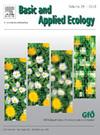Selective observation causes differences in citizen science butterfly data
IF 3.5
2区 环境科学与生态学
Q2 ECOLOGY
引用次数: 0
Abstract
In times of insect decline, the need for biodiversity monitoring data has become increasingly urgent. However, standardised monitoring of biodiversity is time-consuming and cost-intensive. Citizen science (CS) initiatives therefore may provide valuable data and may complement data collected by professionals. Photo-apps equipped with automated taxonomic identification based on artificial intelligence play a central role in CS, at least for well distinguishable organisms such as the majority of butterfly species. In this study, we analysed butterfly (Papilionoidea) observations collected with three different photo-apps (i.e. Blühendes Österreich, iNaturalist, observation.org). We compared these data with observations from the Global Biodiversity Information Facility (GBIF). For this purpose, we classified each butterfly species according to its detectability and attractiveness, as well as its ecology and behaviour. Our results show that the observations obtained from the three photo-apps mainly cover mobile, conspicuous and easy-to-identify species, while the rare and sedentary specialist species and species that are difficult to distinguish from other taxa are underrepresented. Furthermore, the observations collected differ significantly between the three apps, and Blühendes Österreich particularly lacks inconspicuous butterfly species. However, a detailed regional analysis of user performance revealed that the differences among the three apps largely stem from Austrian-wide difference in app usage and less to user specific biases in recording. Within single habitats, amateurs and semi-professional users performed similarly in recording. In consequence, a combination of the data from the various apps might provide a largely realistic picture. However, most rare and ecologically demanding species seem to be covered inadequately. Thus, the recording of such species must be continued by experts to obtain a comprehensive picture of regional biodiversity.
选择性观察导致公民科学蝴蝶数据的差异
在昆虫减少的时代,对生物多样性监测数据的需求日益迫切。然而,生物多样性的标准化监测既耗时又成本高昂。因此,公民科学(CS)计划可以提供有价值的数据,并可以补充专业人员收集的数据。配备了基于人工智能的自动分类识别的照片应用程序在CS中发挥着核心作用,至少对于大多数蝴蝶等易于识别的生物来说是这样。在这项研究中,我们分析了通过三个不同的照片应用程序(即bl hendes Österreich, iNaturalist, observation.org)收集的蝴蝶(Papilionoidea)观察结果。我们将这些数据与全球生物多样性信息设施(GBIF)的观测结果进行了比较。为此,我们根据蝴蝶的可探测性和吸引力,以及生态和行为对每种蝴蝶进行分类。结果表明,三种照片应用程序的观测结果主要集中在移动、显眼和易于识别的物种,而稀有和定居的专业物种和难以与其他分类群区分的物种代表性不足。此外,三个应用程序之间收集的观察结果差异很大,bl hendes Österreich尤其缺乏不显眼的蝴蝶物种。然而,对用户表现的详细区域分析显示,这三款应用之间的差异主要源于奥地利范围内的应用使用差异,而不是用户在记录方面的特定偏见。在单一栖息地内,业余爱好者和半专业用户在记录方面的表现相似。因此,将来自不同应用程序的数据结合起来,可能会提供一个基本真实的画面。然而,大多数稀有和生态要求高的物种似乎没有得到充分的保护。因此,专家必须继续对这些物种进行记录,以获得区域生物多样性的全面情况。
本文章由计算机程序翻译,如有差异,请以英文原文为准。
求助全文
约1分钟内获得全文
求助全文
来源期刊

Basic and Applied Ecology
环境科学-生态学
CiteScore
6.90
自引率
5.30%
发文量
103
审稿时长
10.6 weeks
期刊介绍:
Basic and Applied Ecology provides a forum in which significant advances and ideas can be rapidly communicated to a wide audience. Basic and Applied Ecology publishes original contributions, perspectives and reviews from all areas of basic and applied ecology. Ecologists from all countries are invited to publish ecological research of international interest in its pages. There is no bias with regard to taxon or geographical area.
 求助内容:
求助内容: 应助结果提醒方式:
应助结果提醒方式:


